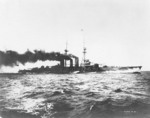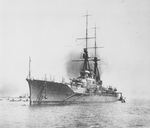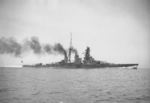Haruna
| Country | Japan |
| Ship Class | Kongo-class Battleship |
| Laid Down | 16 Mar 1912 |
| Launched | 14 Dec 1913 |
| Commissioned | 19 Apr 1915 |
| Sunk | 28 Jul 1945 |
| Displacement | 32,156 tons standard |
| Length | 728 feet |
| Beam | 101 feet |
| Draft | 31 feet |
| Machinery | Steam turbines, 4 boilers, 4 shafts |
| Power Output | 136,000 shaft horsepower |
| Speed | 30 knots |
| Range | 10,000nm at 18 knots |
| Crew | 1,360 |
Contributor: C. Peter Chen
ww2dbaseThe four Kongo-class ships were the first modern warships in the Japanese Navy. They were designed by Britain's Sir George Thurston, and strongly influenced the design of the forthcoming Tiger-class battlecruisers. They were originally rated as "battlecruisers", but pre-WW2 rearmament reclassified them as battleships, though they were relatively lightly armed and armored when compared to their modern battleship counterparts.
ww2dbaseDuring the Second World War, Haruna was extensively employed, often in company with aircraft carriers. In December 1941, she covered the invasion of Malaya. The first four months of 1942 saw her supporting the conquest of the Dutch East Indies, participating in a bombardment of Christmas Island, and participating in the Indian Ocean Raid. In June, she was part of the ill-fated Japanese carrier force during the Battle of Midway and was lightly damaged when a bomb nearly hit her stern. The Guadalcanal Campaign that began in August 1942 also brought Haruna into action. With her sister ship, Kongo, on 14 October she delivered a devastating bombardment of Henderson Field, the U.S. airfield on Guadalcanal. Later in the month, she was present during the Battle of the Santa Cruz Islands and in mid-November operated with the Japanese aircraft carrier force during the climactic Naval Battle of Guadalcanal.
ww2dbaseLike most of the heavier Japanese warships, Haruna saw no combat during 1943 and the first five months of 1944, though she steamed north to Japan in May 1943 in response to the American landings on Attu and was in the central Pacific later in the year during the invasions of the Gilbert Islands and Bougainville. In mid-June 1944, however, the Japanese fleet was sent to counterattack the U.S. forces then assaulting Saipan. As part of the heavily-defended van carrier group, she took an active role in the ensuing Battle of the Philippine Sea and was hit by a bomb on 20 June. Haruna also participated in the Japanese Navy's final fleet action, the Battle of Leyte Gulf. She was damaged by bomb near-misses in the Sibuyan Sea on 24 October 1944, but steamed on to engage U.S. escort carriers and destroyers in the next day's Battle off Samar.
ww2dbaseStationed in Japanese waters by the beginning of 1945, Haruna was damaged at Kure during the U.S. carrier plane raids on 19 March. Still moored near Kure four months later, she was sunk by Task Force 38 aircraft on 28 July 1945. Haruna's wreck was scrapped after the war.
ww2dbaseSource: Naval Historical Center
Last Major Revision: Jan 2005
Battleship Haruna Interactive Map
Photographs
 |  |  |  |
Haruna Operational Timeline
| 19 Apr 1915 | Haruna was commissioned into service. |
| 10 Dec 1941 | Japanese submarine I-58 spotted British battleship HMS Prince of Wales and battlecruiser HMS Repulse off British Malaya, launched five torpedoes, but all of them missed; beginning at 1117 hours, Japanese aircraft began to attack. Overwhelmed, HMS Repulse was sunk at 1233 hours (513 killed), followed by HMS Prince of Wales at 1318 hours (327 killed); destroyers HMS Electra, HMS Express, and HMS Vampire rescued 1,862 survivors. On land, the British commanders dispatched the 1st Battalion of the 14th Punjab Regiment and the 2nd Battalion of the 1st Gurkha Rifles regiment to Changlun and Asun in northern British Malaya to counter the Japanese advance; contact was made at Changlun at 2100 hours, where two Japanese tanks were destroyed before the Punjabi troops fell back toward Asun. |
| 14 Jul 1945 | American battleships USS South Dakota, USS Indiana, and USS Massachusetts and escorting destroyers bombarded Kamaishi, Honshu, Japan; the primary target was the Kamaishi Works of the Japan Iron Company, but several destroyers shells overshot the target and hit the town, killing many civilians; battleship shells were more accurate, destroying about 65% of the industrial complex, but they also killed many civilians; this was the first time the Japanese home islands were subjected to naval bombardment. To the north, the sinking of 6 warships and 37 steamers on the ferry route between Honshu and Hokkaido islands effectively cut off the latter from the rest of the home islands. At Kure in southern Japan, aircraft of US Navy TF 38 damaged carrier Amagi, carrier Katsuragi, and battleship Haruna; at Misawa in northern Japan, G4M bombers that were assigned to partake the planned Operation Ken, which sought to deliver 300 suicide commandos to the Mariana Islands, were destroyed (the American would not know of Operation Ken until after the war). The carriers were escorted by a large naval force that included battleship USS Missouri. Far to the south, the USAAF XXI Bomber Command canceled a long-range P-51 raid from Iwo Jima to attack Meiji and Kagamigahara near Nagoya due to poor weather. |
| 24 Jul 1945 | British TF 37 launched 416 sorties, 261 of which were sent against the Japanese home islands and 155 were for defensive patrols; escort carrier Kaiyo was damaged by British carrier planes. On the same day, American TF 38 launched 600 aircraft against Kure, Nagoya, Osaka, and Miho, sinking battleship-carrier Hyuga, heavy cruiser Tone, and target ship Settsu, and damaging carrier Ryuho, carrier Amagi, battleship-carrier Ise, battleship Haruna, heavy cruiser Aoba, light cruiser Oyodo, transport Kiyokawa Maru; the Aichi aircraft factories at Nagoya were seriously damaged. |
| 28 Jul 1945 | 137 American P-47 aircraft based in Ie Shima, Okinawa, Japan attacked targest in Kyushu, Japan. On the same day, 471 B-29 bombers attacked smaller Japanese cities in the home islands with incendiary bombs. Finally, from the sea, US Navy carrier aircraft struck various Inland Sea ports between Nagoya and northern Kyushu, sinking battleship Haruna, battleship-carrier Ise, heavy cruiser Aoba (in shallow water), and light cruiser Oyodo, and damaging carrier Katsuragi, carrier Hosho, and already beached battleship Settsu. |
Did you enjoy this article or find this article helpful? If so, please consider supporting us on Patreon. Even $1 per month will go a long way! Thank you. Share this article with your friends: Stay updated with WW2DB: |
Visitor Submitted Comments
All visitor submitted comments are opinions of those making the submissions and do not reflect views of WW2DB.
» Arima, Masafumi
» Isawa, Yutaka
» Matsuda, Chiaki
» Ozawa, Jisaburo
Event(s) Participated:
» Dutch East Indies Campaign, Java
» Raids into the Indian Ocean
» Battle of Midway and the Aleutian Islands
» Guadalcanal Campaign
» Mariana Islands Campaign and the Great Turkey Shoot
» Philippines Campaign, Phase 1, the Leyte Campaign
» Preparations for Invasion of Japan
Related Books:
» Imperial Japanese Navy Battleships 1941-45
Partner Sites Content:
» Haruna Tabular Record of Movement
- » 1,150 biographies
- » 337 events
- » 43,917 timeline entries
- » 1,241 ships
- » 350 aircraft models
- » 207 vehicle models
- » 374 weapon models
- » 123 historical documents
- » 260 facilities
- » 470 book reviews
- » 28,540 photos
- » 432 maps
Fleet Admiral Chester W. Nimitz, 16 Mar 1945
Please consider supporting us on Patreon. Even $1 a month will go a long way. Thank you!
Or, please support us by purchasing some WW2DB merchandise at TeeSpring, Thank you!
2 Feb 2011 11:15:00 AM
I own a blue & white flag that commemorating
the dispatch of varlous japanese war ships dated 1944. Kongo,Haruna,Yabiki, Chikuma,Tone,Kumano,Suzuya-Nowake,Kiyoshimo. Autumn,1944. the infermaion is hand retin in ink. If anyone can help me on more infermaion